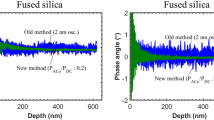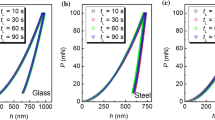Abstract
The indentation properties of human fingernails at varying humidity are reported. The samples were indented using both microindentation, to obtain their Vickers hardness and also nanoindented using a Berkovich indenter tip. The relative humidity (RH) of the samples was controlled by using salt solutions with a sealed and enclosed environment surrounding the testing equipment. It was shown that the Vickers hardness of the samples is sensitive to RH, with recovery of the nail material more readily occurring for nails tested at >55% RH. This recovery mechanism is discussed in terms of the structure of the nails, and this approach is also suggested as a technique for following recovery mechanisms in natural materials under varying humidity. The hardness obtained by nanoindentation is similar to previously published data, but does not change with humidity. The modulus of the nails is also insensitive to relative humidity, but in the same range as the value derived from the microindentation tests.
Similar content being viewed by others
References
G. Achten: Histpathology of the nail, in The Nail, edited by M. Pierre (Churchill Livingstone, 1981), p. 1.
R. Caputo, G. Gasparini, and D. Contini: A freeze-fracture study of the human nail plate. Arch. Dermatol. Res. 272, 117 (1982).
L. Farren, S. Shayler, and A.R. Ennos: The fracture properties and mechanical design of human fingernails. J. Exp. Biol. 207, 735 (2004).
M. Ramrakhiani: Indentation and hardness studies of human nails. Indian J. Biochem. Biophys. 15, 341 (1978).
P. Moran, M.R. Towler, S. Chowdhury, J. Saunders, M.J. German, N.S. Lawson, H.M. Pollock, I. Pillay, and D. Lyons: Preliminary work on the development of a novel detection method for osteoporosis. J. Mater. Sci. Mater. Med. 18, 969 (2007).
R.H.C. Bonser and M.S. Witter: Indentation hardness of the bill keratin of the European starling. Condor 95, 736 (1993).
R.H.C. Bonser: Melanin and the abrasion resistance of feathers. Condor 97, 590 (1995).
R.H.C. Bonser: Comparative mechanics of bill, claw, and feather keratin in the common starling Sturnus vulgaris. J. Avian Biol. 27, 175 (1996).
Y. Seki, M.S. Schneider, and M.A. Meyers: Structure and mechanical behavior of a toucan beak. Acta Mater. 53, 5281 (2005).
Y. Seki, B. Kad, D. Benson, and M.A. Meyers: The toucan beak: Structure and mechanical response. Mater. Sci. Eng., C 26, 1412 (2006).
A.N. Parbhu, W.G. Bryson, and R. Lal: Disulfide bonds in the outer layer of keratin fibers confer higher mechanical rigidity: Correlative nano-indentation and elasticity measurement with an AFM. Biochem. 38, 11755 (1999).
M. Huson, J. Church, and G. Heintze: Spectroscopy, microscopy and thermal analysis of the bi-modal melting of Merino wool. Wool Technol. Sheep Breeding 50, 64 (2002).
G.H. Wei, B. Bhushan, and P.M. Torgerson: Nanomechanical characterization of human hair using nanoindentation and SEM. Ultramicroscopy 105, 248 (2005).
A.Y. Finlay, P. Frost, A.D. Keith, and W. Snipes: An assessment of factors influencing flexibility of human fingernails. Br. J. Dermatol. 103, 357 (1980).
P.W. Winston and D.H. Bates: Saturated solutions for the control of humidity in biological-research. Ecol. 41, 232 (1960).
W.C. Oliver and G.M. Pharr: An improved technique for determining hardness and elastic-modulus using load and displacement sensing indentation experiments. J. Mater. Res. 7, 1564 (1992).
J.W.S. Hearle: A critical review of the structural mechanics of wool and hair fibers. Int. J. Biol. Macromol. 27, 123 (2000).
Author information
Authors and Affiliations
Corresponding author
Rights and permissions
About this article
Cite this article
Farran, L., Ennos, A.R. & Eichhorn, S.J. Microindentation and nanoindentation of human fingernails at varying relative humidity. Journal of Materials Research 24, 980–984 (2009). https://doi.org/10.1557/jmr.2009.0119
Received:
Accepted:
Published:
Issue Date:
DOI: https://doi.org/10.1557/jmr.2009.0119




